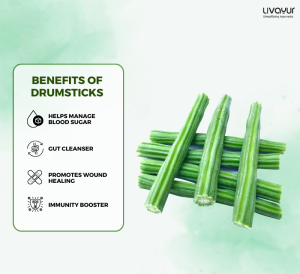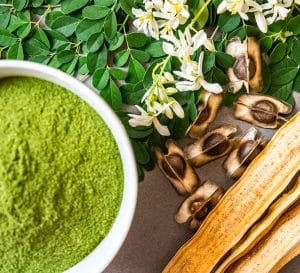
Moringa (whose botanical name is Moringa oleifera) is commonly known in English as drumstick or horseradish. It is known in Hindi as Sahijan or Munaga. It is considered to be an extremely important plant in the ancient Indian practice of Ayurveda. Moringa is a rich source of vegetable oil and scores high when it comes to nutritional values. Moringa leaves and flowers are primarily used to successfully manage several diseases, the most important being diabetes.
Ayurvedic Viewpoint
In Ayurveda, diabetes is known as Madhumeha and is caused because of aggravation of Vata coupled with impaired digestion. This impaired digestion causes an accumulation of Ama (which are toxic remains in the human body) in the cells of the pancreas and leads to the impaired function of insulin. Moringa is efficient in correcting impaired digestion because of its Deepan (appetiser) and Pachan (digestive) properties. This eventually reduces Ama while improving the function of insulin. In addition, Moringa has Tikta or bitter taste which further helps in maintaining normal blood glucose levels. Thus, when it comes to the question, is Moringa good for diabetics? the answer is a resounding yes.
Moringa and Diabetes
Moringa may be beneficial in the successful management of diabetes. It helps in decreasing elevated blood sugar levels. Moreover, it helps in the secretion of insulin from the beta cells of the pancreas. To top it all, it reduces insulin resistance, which is seen in individuals with type 2 diabetes. Moringa for diabetes gets a further shot in the arm because of its anti-inflammatory and antioxidant properties. It successfully inhibits the inflammatory mediators and prevents the occurrence of lipid peroxidation. Therefore, Moringa reduces the high risk of diabetes-related complications.
Medicinal Qualities of Moringa

When it comes to Rasa or taste, it is Katu (pungent) as well as Tikta (bitter). With regards to its Guna or qualities, it is Laghu (light to digest), Rooksha ( dryness) and Teekshna (or strong and piercing). Moringa undergoes a pungent taste conversion post digestion. When it comes to its effect on the Tridoshas, it balances Kapha and Vata.
Parts Used
Moringa’s leaves, root bark, stem bark, seeds and fruits are all known for their therapeutic purposes. They possess their own unique medicinal characteristics and qualities.
Varieties of Moringa
With regards to Moringa diabetes benefits, there are three primary varieties, which are explained in Ayurvedic books.
- Shyama or Black Variety
- Shveta or White Variety
- Rakta or Red Variety. This variety is also known as Madhu Shigru.
What is the Best Way to Take Moringa for Diabetes?
- Take ¼-½ teaspoon of Moringa powder.
- Mix it with water or pure honey.
- Consume it during lunch or dinner to successfully manage diabetes.
Moringa Leaves for Diabetes
Moringa leaves helps in promoting the healthy functioning of the pancreas and the liver by enhancing the digestive fire because of its Deepan and Pachan properties. With regards to Moringa leaves benefits for diabetes, the primary benefit lies in the regulation of blood glucose levels by the prevention of damage to the pancreatic cells. Another benefit is the enhancement in the secretion of insulin.
How to Add Moringa to Your Daily Diet?
You may consume moringa leaves and seeds in three distinct ways – raw leaves, powder and juice. The Moringa tree is revered as a miracle tree because every part of it has some therapeutic value. Some of the tips to incorporate moringa in your daily diet are given below.
Moringa Leaf Tea
You may add a few moringa leaves to warm water and then boil it. For enhanced taste, you may add a dash of honey and lemon. You can consume this concoction as a form of tea.
Moringa Capsules or Tablets
Moringa pills for diabetes can be easily procured from your local pharmacy store. All you need to do is pop a couple of pills a day along with water to derive its benefits.
As a Vegetable
Moringa is native to India, where the plant’s pods and leaves are used to make delectable curries. Some other Asian countries such as Thailand also make use of moringa as a vegetable.
In Salads and Soups
Dressing a salad with a few moringa leaves and pods can enhance the dish’s taste. Moreover, moringa powder or moringa leaves sprinkled onto your soups can serve as effective taste enhancers while simultaneously providing relief from symptoms of diabetes.
This article is reviewed by Dr. Jyoti Lakhani






















